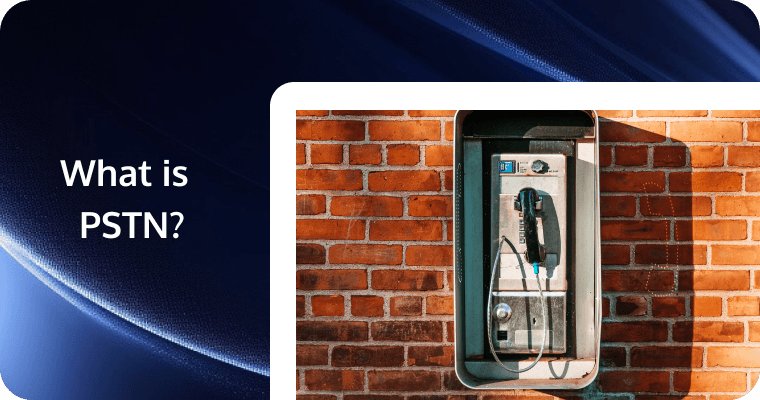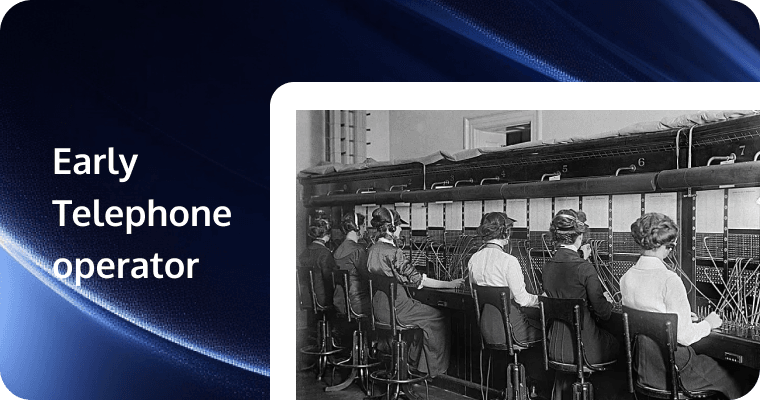In today's digital world, communication technology is developing rapidly. However, we cannot ignore that there is a technology that has dominated the communication field for decades, which is PSTN (Public Switched Telephone Network) technology. Although in the Internet age, we rely more on VoIP, mobile communications and instant messaging applications, the importance and influence of PSTN technology cannot be ignored.
Imagine that decades ago, when we needed to communicate with relatives and friends far away, we could only do it through dial-up phones. At that time, PSTN technology was our bridge to communicate with the world, connecting people's voices and thoughts, and transmitting information thousands of miles away. It is our window, allowing us to hear voices from afar and share joys and sorrows.
However, PSTN technology is not just a simple way of communication. It is a large and complex system consisting of switches, transmission lines, telephones, etc. Its development has gone through multiple stages, from the initial analog transmission to digital innovation, which has brought great changes to the communication industry.
In this blog, we will delve into the story behind PSTN technology to understand how it works, how it has developed, and how it affects our daily lives. We will explore its strengths and limitations, as well as its place in modern communications. Whether you are a professional interested in communications technology or just curious about the history of technology development, this blog will demystify PSTN technology for you.

What is PSTN?
PSTN (Public Switched Telephone Network) is a traditional telephone communication network, which is a communication system that connects telephone users through physical lines. PSTN technology is based on the traditional circuit switching principle, which realizes telephone communication through switches and transmission lines.
In PSTN, telephone signals are transmitted in analog form and transmitted through transmission media such as copper wires. When a telephone user dials, the signal is routed to the target user's telephone line through the switch, thus establishing a call connection. This traditional circuit switching method ensures the stability and quality of the call, allowing users to have high-quality voice communication.
The definition of PSTN technology covers the entire infrastructure of the telephone network, including switches, transmission lines, telephones and other related equipment. It provides a reliable communication infrastructure that enables users to make voice calls worldwide and supports a range of telephone services such as call forwarding, voicemail and call waiting.

Why is PSTN Important?
Despite the rise of new technologies such as VoIP, mobile communications and instant messaging in the Internet era, PSTN technology still has an important position and importance in the field of communications. The following are several key positions and importance of PSTN technology:
- Reliability and stability: PSTN technology is based on the traditional circuit switching principle, connecting telephone users through physical lines, providing stable and reliable communication services. Compared with Internet-based communication technology, PSTN is more stable in the face of network congestion, network disconnection or other network problems, ensuring the quality and continuity of calls.
- Voice quality: PSTN technology has excellent quality in voice communication. Because the signal is transmitted in analog form and passes through dedicated transmission lines, PSTN is able to provide a high-quality voice call experience, reducing delays, noise and other interference in calls.
- Global coverage: PSTN technology is widely used around the world, building a huge telephone network infrastructure. This allows users to make voice calls all over the world, whether it is domestic calls or international long-distance calls, PSTN can provide reliable connections.
- Telephone service support: PSTN technology not only provides basic voice communication functions, but also supports a series of telephone services such as call forwarding, voicemail, call waiting, conference calls, etc. These services provide users with more flexibility and convenience, and meet the communication needs of different users.
- Specific industry needs: In some specific industries and applications, such as finance, medical care, emergency rescue, etc., PSTN technology is still indispensable. These industries have higher requirements for communication reliability, security and voice quality, and PSTN can meet these needs.
Although PSTN technology faces competition and challenges from new technologies, it still plays an important role in many regions and scenarios. Its reliability, stability and voice quality make it the first choice for some specific needs, and it also provides us with a historical foundation and important reference for the development of communication technology.
What is the Basic Principle of PSTN?
PSTN technology is based on the traditional circuit switching principle, connecting telephone users through physical lines, and routing signals and connecting calls through switches. It provides a reliable communication infrastructure, converts the user's voice into electrical signals for transmission, and realizes voice calls through telephone sets. Additional features further enhance the flexibility and functionality of PSTN technology:
- Telephone line connection: PSTN technology connects the communication system between telephone users through physical lines. These lines can be copper wires, optical fibers, or other transmission media. Each telephone user has a unique telephone number and communicates through these lines.
- Switches: The switches in the PSTN network are key components used to route telephone signals and establish call connections. The switch routes the signal from the sender to the receiver's telephone line based on the number information dialed by the user. The switch can be a local exchange or a remote exchange.
- Signal transmission: PSTN technology was originally based on analog transmission, that is, converting sound signals into analog electrical signals for transmission. However, with the development of digital technology, PSTN has gradually turned to digital transmission, converting sound signals into digital data for transmission.
- Telephone: The telephone is the terminal equipment of PSTN technology, which is used by users to make voice calls. The telephone converts the user's voice into electrical signals by connecting to the telephone line and sends it to the PSTN network. Similarly, it can also receive signals from the network and convert them into audible sounds.
- Additional functions: In addition to basic voice communication, PSTN technology also supports a series of additional functions, such as call forwarding, voicemail, call waiting, conference calls, etc. These functions provide users with more communication flexibility and convenience through the support of switches and other related equipment.
What are the Scenarios for Using PSTN?
PSTN (Public Switched Telephone Network) technology is widely used in many different scenarios. Here are some specific examples of use scenarios:
- Home and personal communication: PSTN technology is the basis of home and personal communication, and people can use traditional telephones to make voice calls. Whether at home or in a personal office, PSTN provides reliable telephone communication services.
- Business communication: Many enterprises and organizations rely on PSTN technology for business communications. The telephone system in the office is usually connected to the PSTN network, enabling employees to make internal and external voice calls.
- Public service agencies: Many public service agencies, such as hospitals, police stations, fire stations, etc., still use PSTN technology for communication. These agencies have higher requirements for communication reliability and voice quality, and PSTN can meet these needs.
- Emergency rescue: In an emergency, people usually call emergency numbers (such as 911), which are connected to the PSTN network, allowing people to quickly communicate with emergency rescue agencies.
- Rural and remote areas: In some remote areas, PSTN technology may be the only available communication option. Because PSTN has established a global telephone network infrastructure, it can provide communication services even in places without Internet or mobile network coverage.
- International long-distance calls: PSTN technology enables people to make international long-distance calls, connecting telephone users in different countries and regions through international telephone networks.
These are just some examples of the use scenarios of PSTN technology, and it also plays an important role in many other fields and applications. Despite the competition from new technologies, PSTN is still one of the important ways for many people to communicate on a daily basis.
Comparison of PSTN Technology And Others
PSTN (Public Switched Telephone Network) has some unique advantages and disadvantages compared to other similar communication technologies. Here is a simple comparison and advantages and disadvantages of PSTN and other technologies:
| Compare With | Advantages | Disadvantages |
| VoIP (Voice over Internet Protocol) |
|
|
| Mobile Communication Technology |
|
|
| Instant Messaging Applications |
|
|
In short, PSTN technology has advantages in voice quality, stability, and global coverage, but may not be as good as other technologies in terms of cost and flexibility. Choosing the right communication technology depends on specific needs and scenarios, and comprehensive consideration of various factors can find the most suitable solution.
Conclusion
The traditional Public Switched Telephone Network (PSTN), as one of the earliest communication networks, uses circuit-switching technology. While it provides stable voice call services, it has limitations such as low resource utilization and high line costs. With the development of Internet technology, IP-based VoIP technology emerged, transmitting voice data in packets, greatly improving network resource utilization and reducing communication costs.
Today's Tencent Real-Time Communication (TRTC) represents a further innovation built upon this foundation. It not only inherits the cost advantages of IP networks but also features deep optimizations specifically for real-time scenarios. TRTC employs advanced audio/video codec technology, intelligent network transmission strategies, and anti-packet loss algorithms to maintain low-latency and high-quality communication experiences even in complex network environments.
Furthermore, TRTC supports rich features including multi-person real-time audio/video calls, screen sharing, and beauty filters, while enabling seamless cross-platform deployment. Its robust server cluster architecture can support massive concurrent connections, meeting the demands of various real-time interactive scenarios such as online education, telemedicine, and video conferencing.
Additionally, TRTC provides comprehensive SDKs and API interfaces, significantly lowering the development barrier and enabling developers to quickly build real-time interactive applications. If you have any questions or need assistance, our support team is always ready to help. Please feel free to Contact Us or join us in Telegram.


